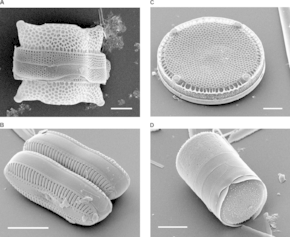Frustule
A frustule is the hard and porous cell wall or external layer of diatoms. The frustule is composed almost purely of silica, made from silicic acid, and is coated with a layer of organic substance, which was referred to in the early literature on diatoms as pectin, a fiber most commonly found in cell walls of plants.[1][2] This layer is actually composed of several types of polysaccharides.[3]

The frustule's structure is usually composed of two overlapping sections known as thecae (or less formally as valves). The joint between the two thecae is supported by bands of silica (girdle bands) that hold them together. This overlapping allows for some internal expansion room and is essential during the reproduction process. The frustule also contains many pores and slits that provide the diatom access to the external environment for processes such as waste removal and mucilage secretion.
The microstructural analysis of the frustules shows that the pores are of various sizes, shapes and volume. The majority of the pores are open and do not contain impurities. The dimensions of the nanopores are in the range 250–600 nm.[4][5][6]
Thecae
A frustule is usually composed of two identically shaped but slightly differently sized thecae. The theca which is a bit smaller has an edge which fits slightly inside the corresponding edge of the larger theca. This overlapping region is reinforced with silica girdle bands, and constitutes a natural "expansion joint." The larger theca is usually thought of as "upper," and is thus termed the epitheca. The smaller theca is usually thought of as "lower," and is thus called the hypotheca.[1] As the diatom divides, each daughter retains one theca of the original frustule and produces one new theca. This means that one daughter cell is the same size as the parent (epitheca and new hypotheca) while in the other daughter the old hypotheca becomes the epitheca which together with a new and slightly smaller hypotheca comprises a smaller cell.
Diatoms
Diatoms have varied life strategies including floating in the water column (phytoplankton), colonising submerged surfaces and living within the surface of deposited sediments. Some cells are essentially cylindrical (centric) while others have an elongated "boat-like" shape. Since they are algae belonging to the division Bacillariophyta they require light for photosynthesis. Perhaps the most studied group of diatoms belong to the phytoplankton. Phytoplanktonic diatoms rely on ocean currents and wind to keep them in the upper oceanic levels as their cell wall is denser than water around them. They would naturally sink otherwise.
Diatom skeletons and their uses
When diatoms die and their organic material decomposes, the frustules sink to the bottom of the aquatic environment. This remnant material is diatomite or "diatomaceous earth", and is used commercially as filters, mineral fillers, mechanical insecticide, in insulation material, anti-caking agents, as a fine abrasive, and other uses.[7] There is also research underway regarding the use of diatom frustules and their properties for the field of optics, along with other cells, such as those in butterfly scales.[2]
Frustule formation
As the diatom prepares to separate it undergoes several processes in order to start the production of either a new hypotheca or new epitheca. Once each cell is completely separate they then have similar protection and the ability to continue frustule production.[8]
A brief and extremely simplified version can be explained as:[8]
- The newly formed nucleus and the pre-existing nucleus each move to the side of the diatom where the new hypotheca will be formed.
- A vesicle known as the silica deposition vesicle forms near the plasma membrane.
- This forms the center of the pattern and silica deposition can continue outward from that point, till the frustule is produced.
References
- "Diatoms: More on Morphology".
- Parker, Andrew R.; Townley, Helen E. (3 June 2007). "Biomimetics of photonic nanostructures". Nature Nanotechnology. 2 (6): 347–353. Bibcode:2007NatNa...2..347P. doi:10.1038/nnano.2007.152. PMID 18654305.
- Progress in Phycological Research: v. 7 (1991) by F.E. Round (Volume editor), David J. Chapman (Volume editor)
- Reka, Arianit; Anovski, Todor; Bogoevski, Slobodan; Pavlovski, Blagoj; Boškovski, Boško (29 December 2014). "Physical-chemical and mineralogical-petrographic examinations of diatomite from deposit near village of Rožden, Republic of Macedonia". Geologica Macedonica. 28 (2): 121–126.
- Reka, Arianit A.; Pavlovski, Blagoj; Makreski, Petre (October 2017). "New optimized method for low-temperature hydrothermal production of porous ceramics using diatomaceous earth". Ceramics International. 43 (15): 12572–12578. doi:10.1016/j.ceramint.2017.06.132.
- Reka, Arianit A.; Pavlovski, Blagoj; Ademi, Egzon; Jashari, Ahmed; Boev, Blazo; Boev, Ivan; Makreski, Petre (31 December 2019). "Effect Of Thermal Treatment Of Trepel At Temperature Range 800-1200˚C". Open Chemistry. 17 (1): 1235–1243. doi:10.1515/chem-2019-0132.
- Diatom Frustule 2
- Zurzolo, Chiara; Bowler, Chris (1 December 2001). "Exploring Bioinorganic Pattern Formation in Diatoms. A Story of Polarized Trafficking". Plant Physiology. 127 (4): 1339–1345. doi:10.1104/pp.010709.
External links
- Frustule on Britannica
- diatom frustule on astrographics.com
- Geometry and Pattern in Nature 1: Exploring the shapes of diatom frustules with Johan Gielis' Superformula, by Christina Brodie, UK
Regarding the Super formula
- Exploring the miniature world on microscopy-uk.org.uk
- Superellipse And Superellipsoid, A Geometric Primitive for Computer Aided Design, by Paul Bourke, January 1990
- Supershapes (Superformula) by Paul Bourke, March 2002
